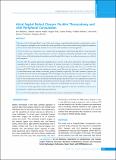Please use this identifier to cite or link to this item:
https://hdl.handle.net/20.500.14356/1199| Title: | Atrial Septal Defect Closure Via Mini Thoracotomy and with Peripheral Cannulation |
| Authors: | Bhattarai, Anil Paudel, Basanta Sharma Shah, Sangam Pandey, Apsara Khakural, Prabhat Baral, Ravi Thapaliya, Kalanath Koirala, Bhagawan |
| Citation: | BhattaraiA., Sharma PaudelB., ShahS., PandeyA., KhakuralP., BaralR., ThapaliyaK., & KoiralaB. (2022). Atrial Septal Defect Closure Via Mini Thoracotomy and with Peripheral Cannulation. Journal of Nepal Health Research Council, 19(04), 725-729. https://doi.org/10.33314/jnhrc.v19i04.3904 |
| Issue Date: | 2021 |
| Publisher: | Nepal Health Research Council |
| Article Type: | Original Article |
| Keywords: | Atrial septal defect Nepal sternotomy thoracotomy total peripheral cannulation |
| Series/Report no.: | Oct-Dec, 2021;3904 |
| Abstract: | Abstract Background: Atrial septal defect is one of the most common congenital cardiac disorders requiring intervention. We compared a minimally invasive method for atrial septal defect closure that included total peripheral cannulation and an anterior mini-thoracotomy incision of 5 cm or less with a median sternotomy approach. Methods: This was a retrospective cross-sectional study among patients with Atrial Septal Defect. The preoperative variables, intraoperative data, and postoperative outcomes of patients undergoing minimally invasive atrial septal defect closure with total peripheral cannulation and atrial septal defect closure via median sternotomy were collected and compared. Results: Fifty-five patients underwent minimally invasive closure of the atrial septal defect with total peripheral cannulation and 55 patients that underwent surgery by median sternotomy were included for comparison. There were 61.81% (34) female and 38.18% (21) male in the mini-thoracotomy group while there were 52.72% (29) female and 47.27% (26) male in the median sternotomy group. The mean age at surgery was 23.4 and 28.6 years in mini-thoracotomy and median sternotomy groups of patients respectively. The most common symptom was exertional shortness of breath in both groups. The mean length of stay in the intensive care unit was 1.8 and 2.5 days in mini-thoracotomy and median sternotomy groups respectively, and the length of stay in the hospital was 4.5 days and 4.8 days in mini-thoracotomy and median sternotomy groups respectively. There was a significant association was found between the mini-thoracotomy and median sternotomy group in relation to mean size of the incision, average time for cardiopulmonary bypass, average cross-clamp time, and fluid drained on the first day after surgery. Conclusions: Atrial septal defect closure with a mini-invasive approach is safe and cost-effective with very few perioperative complications and good patient satisfaction. Keywords: Atrial septal defect; Nepal; sternotomy; thoracotomy; total peripheral cannulation. |
| Description: | Original Article |
| URI: | http://103.69.126.140:8080/handle/20.500.14356/1199 |
| ISSN: | Print ISSN: 1727-5482; Online ISSN: 1999-6217 |
| Appears in Collections: | Vol. 19 No. 04 (2021): Vol 19 No 4 Issue 53 Oct-Dec 2021 |
Files in This Item:
| File | Description | Size | Format | |
|---|---|---|---|---|
| 3904-Manuscript-26781-1-10-20220313.pdf | Fulltext Download | 182.12 kB | Adobe PDF |  View/Open |
Items in DSpace are protected by copyright, with all rights reserved, unless otherwise indicated.
